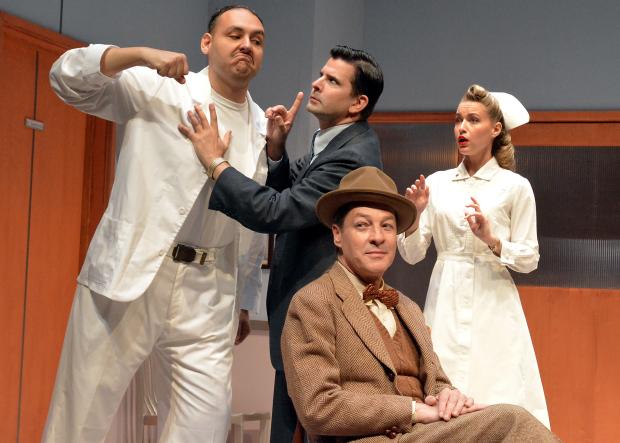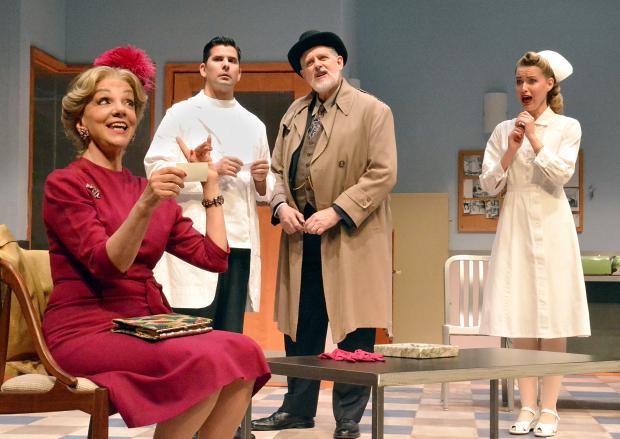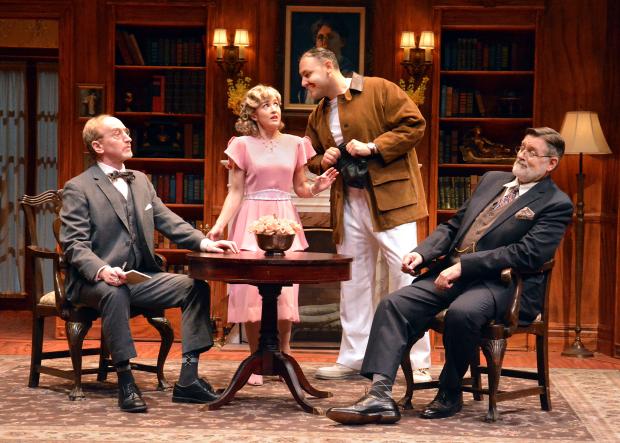Seventy-five years ago playwright Mary Chase’s Harvey started hip-hopping across the stage for four and a half years, as this whimsical classic about a great white rabbit went on to have one of the longest theatrical runs in Great White Way history. Chase’s three act play rather famously depicted well-to-do Ellwood P. Dowd, owner of a posh home somewhere in the Far West, also inhabited by his sister Veta Louise Simmons, his 20-ish niece Myrtle Mae and - much to the chagrin of the mother and daughter - the titular six-foot, three-and-one-half-inch, invisible rabbit. Ellwood regards Harvey to be his best friend, but his sister and niece consider the hare’s purported existence to be apocryphal and a source of embarrassment. Hilarity ensues.
The original Harvey was co-directed by Antoinette Perry, whose name would subsequently be attached to Broadway’s glittering accolades. However, before those Tony Awards were launched, Harvey won an even more prestigious laurel: the Pulitzer Prize for Drama. And a year after the comedy closed on the legit stage Jimmy Stewart rather memorably starred in Hollywood’s 1950 Harvey, earning him Oscar and Golden Globe nominations, while Josephine Hull won both of those awards for playing Veta.
So French Stewart and Vanessa Claire Stewart have their hands (or perhaps I should say “paws”?) full filling the shoes of the acclaimed thespians who preceded them in portraying Ellwood and his sister, Veta, in a two-act version of this much beloved and honored production. The good news is that Stewart (that is, French, not Jimmy) admirably succeeds in pulling a rabbit out of his hat with a performance that showcases French’s penchant for physical comedy, as well as his impeccable comic timing in delivering Chase’s witty lines.
French, of course, honed his comedic skills acting in TV sitcoms such as 3rd Rock from the Sun and currently on the CBS series Mom. Although best known for his little screen work, Stewart is also a stage stalwart and I’ve had the pleasure of witnessing him portray Sigmund Freud and Queen Victoria in the 2012 Sherlockian spoof Watson: The Last Great Tale of the Legendary Sherlock Holmes for the Sacred Fools Theater Company; a character based on actor Jack Gilford in Rogue Machine’s 2018 Hollywood Blacklist era drama Finks; and, best of all, as the immortal silent movie comedian Buster Keaton in Stoneface at Sacred Fools in 2012 and then Pasadena Playhouse in 2013.
The latter was written for her husband by Vanessa Claire Stewart, who also co-starred with French in Finks as, fittingly, his love interest. Vanessa won an LA Weekly best actress award for playing Alex in a stage version of A Clockwork Orange, as well as Ovation Awards for co-writing and starring in 2009’s venerated Louis and Keely: Live at the Sahara, which started out on Sacred Fools’ intimate stage but went on to be mounted at larger theaters, including the Geffen and Laguna Playhouses.
Whereas French and Vanessa’s characters in Finks were husband and wife, in Harvey the real life married couple play siblings. In 2018 I interviewed French for @ This Stage, asking: “What’s it like appearing in a play with your wife, Vanessa? Is this the first time you’ve acted together?” Stewart responded:
“Yeah, it’s the first time we’ve acted together. It’s really lovely because there are giant parts of Finks that really overlap our lives... in show business. Certain pressures that come up and certain situations you find yourself in. That was why when we both read it we thought, ‘oh, we’ve got to do it.’ We felt we had a lot to say.”
When playwright Mary Chase grew up in Colorado, she was influenced by her older brother, who became a circus clown, plus by her four uncles who, along with Mary’s mother, during her childhood imparted a love of Celtic folklore to the future bard, who had the gift of the blarney.
The character of Harvey is inspired by Irish myths, which include magical beings such as leprechauns and pookas (there are various spellings), shape-shifting legendary creatures endowed with different powers. Is Harvey a pooka or is the invisible rabbit merely a figment of Ellwood’s alcohol-fueled imagination, an imaginary friend concocted to help Dowd cope with reality? Is Harvey a bigger fantasy than Hugh Hefner’s bunnies?
This is the central theme of Harvey, as Veta and Myrtle Mae Simmons (the funny and randy Lily Gibson portraying an archetypal “dumb blonde”) conspire to have Ellwood committed to an institution, Chumley’s Rest, to “cure” him of his perpetual bar-hopping, lollygagging, and frittering away of his potential and prestige in the town where, given his family background, the (apparent) heir could serve on various boards of directors. But instead of becoming a pillar of bourgeois society, Ellwood would rather suck ’em up with Harvey down at Charlie’s saloon or the local fire station.
Not incidentally, confining Ellwood to an asylum would enable his sister and niece to assume ownership of that capacious home - and, presumably, the brother/uncle’s endless supply of coinage for making those naughty nightly pub crawls with his “pal” Harvey.
The Laguna Playhouse’s ample boards are divided in half, between the library at the Dowds’ great home and the mental institution where Ellwood faces being institutionalized. (Both sets were expertly rendered by scenic designer Bruce Goodrich.) Ultimately, Chase’s play is about the leitmotif of conformity. At one point, at Chumley’s Rest, Ellwood ruminates to a shrink: “Well, I've wrestled with reality for 35 years, Doctor, and I'm happy to state I finally won out over it.” When Stewart adeptly uttered the line theatergoers at the Laguna Playhouse applauded.
Another nugget of Dowd’s philosophical wisdom pleased the Laguna audience too: “Years ago my mother used to say to me, she'd say, ‘In this world, Elwood, you must be’ - she always called me Elwood - ‘In this world, Elwood, you must be oh so smart or oh so pleasant.’ Well, for years I was smart. I recommend pleasant. You may quote me.”
Some ticket buyers may think Laguna Playhouse’s production to have a screwball panache, while others may find this iteration of a play first produced in 1944 to be on the stagey and theatrical side. Andrew Barnacle deftly directs his cast of characters incarnated by character actors who all have a comic verve, including Larry Cedar (of HBO’s Deadwood) as Judge Gaffney, who is concerned about being gaff prone when considering the disposition of Ellwood’s estate - and liberty.
Of course, just as Laguna Playhouse gave auds an opportunity see the movie star Melanie Griffith last year live in the stage version of The Graduate, Harvey gives viewers the chance to see a television star perform live and in the flesh. In my interview with French I asked him: “You appear on TV shows such as the network sitcom Mom and in movies. Presumably they pay much better than L.A. theatre does. So why do you do it?”
Stewart replied: “I mean, my love and a place where I won’t get penned into playing just one kind of part is theatre. I like small theatres because it’s so intimate. I like large theatres, too. But that’s where I really get to work out in front of an audience and get better. That’s where my wife started playing small and growing, so there are jobs later on for actors that are playing. Vanessa did it with Stoneface and Louis and Keely Live at the Sahara. …I’m not adverse to somebody saying I’d like to waive my rights so that I can work out and work with my friends and become better and make something that will grow and make us all better as artists. Because there aren’t lots of TV jobs. But there are lots of actors, and they need something to do.”
Keep your eyes peeled during Harvey’s final scene for some special effects that may answer the question as to whether or not Harvey is real or just a nowhere hare, a mere caprice of Ellwood’s addled noggin. Look closely - as my father used to joke, rabbits have perfect eyesight, the proof being: Have you ever seen a rabbit wearing glasses? Don’t take your eyes off the stage!
Harvey is playing through June 16 on Tuesdays through Saturdays at 7:30 p.m.; 2:00 p.m. on Saturdays and on Tuesday June 4 and Thursday June 13; and Sundays at 1:00 p.m. and Sunday, June 9 at 5:30 p.m.; at the Laguna Playhouse, 606 Laguna Canyon Road, Laguna Beach, CA 92651. For more info: (949)497-2787; www.LagunaPlayhouse.com.
L.A.-based reviewer/film historian Ed Rampell co-authored “The Hawaii Movie and Television Book” available at: https://mutualpublishing.com/product/the-hawaii-movie-and-television-book/.



